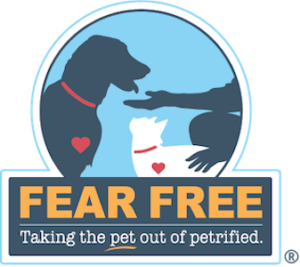Parasites are no fun for dogs, and they’re no fun for veterinarians, either. The last thing you want is to find out your client’s dog has been living with worms for months. That discovery can disrupt the bond between the dog and the owner and may even make you feel like you let your client down.
You want to prevent anxiety, reduce stress and keep it Fear Free for your clients, but it can be challenging if they don’t volunteer the information you need to gauge their dog’s risk for parasitic infection. For situations like this, the following questions can help you evaluate a dog’s current risk level so you can make the most informed treatment decisions. And as a bonus, answering these questions will also help owners realize just how often their dogs face potential parasitic exposure.
“How often does your dog play around in the backyard or go out for walks?”
The more time a dog spends outside, the higher his risk for parasite exposure. This is true even if the dog only spends time in his own backyard or goes out for a walk around the neighborhood twice a day.
Remind owners how often dogs nose around in the dirt and grass while out on walks. This behavior seems harmless enough, but it could lead to parasitic infection if the dog ingests worm eggs or larvae from contaminated soil.1,2
“Do you ever see other animals in your neighborhood, like field mice or raccoons, or does your dog ever visit wooded areas?”
Most owners don’t realize that other animals can also ingest parasite eggs and become carriers of infection. The infection can spread to the dog if he ingests the animal’s feces or eats the animal.2,3 Even if your clients live in an urban area, their dogs can still encounter wildlife in city parks and other areas with trees or vegetation.
“Does your dog play with other dogs or visit areas where pets tend to congregate, like dog parks?”
The more a dog socializes with other animals, the more likely they are to come in contact with feces contaminated with parasite eggs or larvae. Dog parks in particular are areas to watch out for, as they contribute to the spread of parasites like hookworm, whipworm and roundworm. In a pilot study conducted across the Dallas-Fort Worth area, 80% of sampled dog parks had at least one dog test positive for intestinal parasites.4
“Do you know which worms your dog’s parasite protection covers?”
Most of the time, clients don’t know about the different types of parasitic infections or what their dog is currently protected against. Make sure they understand just how much coverage they have. If your client is not using broad-spectrum internal parasite protection for heartworm, hookworms, roundworms, whipworms and tapeworms year-round, let them know that that their dog is at increased risk from parasites.
References
-
- Companion Animal Parasite Council. Trichuris vulpis. Available at: https://www.capcvet.org/guidelines/trichuris-vulpis/. Accessed May 16, 2018.
- Companion Animal Parasite Council. Hookworms. Available at: https://www.capcvet.org/guidelines/hookworms/. Accessed May 16, 2018.
- Companion Animal Parasite Council. Ascarid. Available at: https://www.capcvet.org/guidelines/ascarid/. Accessed May 16, 2018.
- Elanco Animal Health. Data on file.
This article was reviewed/edited by board-certified veterinary behaviorist Dr. Kenneth Martin and/or veterinary technician specialist in behavior Debbie Martin, LVT. This post is brought to you by our sponsor, Elanco, the makers of Credelio® (lotilaner) and
This post is brought to you by our sponsor, Elanco, the makers of Credelio® (lotilaner) and
Interceptor® Plus (milbemycin oxime/praziquantel).
INDICATIONS FOR CREDELIO
Credelio kills adult fleas and is indicated for the treatment and prevention of flea infestations (Ctenocephalides felis) and the treatment and control of tick infestations [Amblyomma americanum (lone star tick), Dermacentor variabilis (American dog tick), Ixodes scapularis (black-legged tick) and Rhipicephalus sanguineus (brown dog tick)] for one month in dogs and puppies 8 weeks of age and older, weighing 4.4 pounds or greater.
IMPORTANT SAFETY INFORMATION FOR CREDELIO
Lotilaner is a member of the isoxazoline class. This class has been associated with neurologic adverse reactions including tremors, ataxia, and seizures. Seizures have been reported in dogs receiving this class of drugs, even in dogs without a history of seizures. Use with caution in dogs with a history of seizures or neurologic disorders. The safe use of Credelio in breeding, pregnant or lactating dogs has not been evaluated. The most frequently reported adverse reactions are weight loss, elevated blood urea nitrogen, increased urination, and diarrhea. For full prescribing information see Credelio package insert.
INDICATIONS FOR INTERCEPTOR PLUS
Interceptor Plus prevents heartworm disease (D. immitis) and treats and controls adult hookworm (A. caninum), roundworm (T. canis, T. leonina), whipworm (T. vulpis) and tapeworm infections (T. pisiformis, E. multilocularis, E. granulosus and D. caninum) in dogs and puppies 6 weeks or older and 2 pounds or greater.
IMPORTANT SAFETY INFORMATION FOR INTERCEPTOR PLUS
Treatment with fewer than 6 monthly doses after the last exposure to mosquitoes may not provide complete heartworm prevention. Prior to administration of Interceptor Plus (milbemycin oxime/praziquantel), dogs should be tested for existing heartworm infections. The safety of
Interceptor Plus has not been evaluated in dogs used for breeding or in lactating females. The following adverse reactions have been reported in dogs after administration of milbemycin oxime or praziquantel: vomiting, diarrhea, depression/lethargy, ataxia, anorexia, convulsions, weakness, and salivation. Please see full Interceptor Plus product information for complete safety information or contact your veterinarian.
Credelio, Interceptor, Elanco and the diagonal bar logo are trademarks of Elanco or its affiliates.
© 2019 Elanco. PM-US-19-1901




